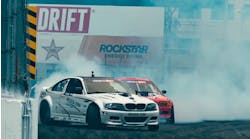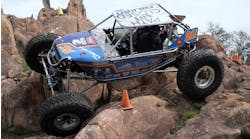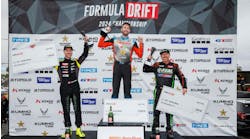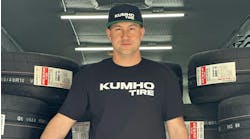At 21 races it is the longest season in Formula One history, yet it has moved through the calendar so swiftly that the season-ending Abu Dhabi Grand Prix Nov. 27 at Yas Marina Circuit is nearly upon the inhabitants of the 2016 FIA Formula One World Championship.
Perhaps the pace of the season and the quickness of calendar pages turning is par for the course in Formula One, but for Haas F1 Team there was neither par nor course.
Haas F1 team is the first American Formula One team in 30 years, and 20 races into its debut season it is very much a part of the Formula One paddock. But before cars began turning wheels in anger during preseason testing back in late February and early March at Circuit de Barcelona – Catalunya, the main question facing Haas F1 Team was, “Are they for real?”
It was a question first asked in January 2014 when team founder and chairman Gene Haas responded to the FIA’s expression of interest. When the FIA granted Haas a Formula One license in April 2014, the question persisted.
The frequency of the query ebbed in September 2014 when Haas F1 Team formed a technical partnership with Scuderia Ferrari. And a year later when drivers Romain Grosjean and Esteban Gutiérrez were signed for the team’s inaugural season, it injected another dose of reality that Haas F1 Team was, in fact, for real.
Yet for those outside of Haas F1 Team, there was no car to see. No transporters. No tangible evidence that this new team with a headquarters in NASCAR country would be on the grid in 2016.
But then preseason testing at Barcelona happened. Way down at the far end of the paddock, an immaculate trio of transporters sat with a large, red circle “H” emblazoned across shiny, gray paint. Behind the transporters was a sharp-looking entrance to a garage area, further emulating the colors of Haas Automation, the largest CNC machine tool builder in North America. Inside that garage, attended to by a phalanx of crew members in uniforms matching the team’s branding, was the VF-16, Haas F1 Team’s very first racecar.
At 10 a.m. CET on Monday, Feb. 22, the VF-16 roared to life. With Grosjean at the wheel, it pulled out of the garage and onto the pit lane at Barcelona. The Ferrari 061 turbo V-6 ran flawlessly around the 4.655-kilometer (2.89-mile), 16-turn track, providing a valuable reconnaissance lap for the team to check all the car’s systems. Haas F1 Team had arrived. Proving it was the final testing tally of 474 laps (2,206.47 kilometers, 1,369.86 miles) during the eight days of track time (Feb. 22-25, March 1-4).
It was a very good first impression, but testing is not racing, so the questions about Haas F1 Team persisted. But then came a sixth-place finish in the season-opening Australian Grand Prix followed by a fifth-place result in the second race of the season in Bahrain. And now as the season finale beckons at the 5.554-kilometer (3.451-mile), 21-turn Yas Marina Circuit, Haas F1 Team has 29 points and sits a solid eighth in the constructor standings.
The 29 points Haas F1 Team has earned so far this season are the most of any new team in this millennium. When Jaguar debuted in 2000 and when Toyota came on the scene in 2002, each entity managed only two point-paying finishes in their entire first seasons for a combined total of six points.
It’s a significant piece of history that Haas F1 Team now owns, along with these anecdotes secured on its march toward Abu Dhabi:
● When Grosjean finished sixth at Australia to score eight points, it was the first time a Formula One team scored points in its debut race since 2002 when Mika Salo finished sixth for Toyota in the Australian Grand Prix.
● When Haas F1 Team development driver Santino Ferrucci took his first laps in a Formula One car at England’s Silverstone Circuit on the Tuesday after the British Grand Prix, it marked the first time an American driver had wheeled an American Formula One car since Oct. 9, 1977 when Danny Ongais drove a Penske PC4 in the Canadian Grand Prix at Mosport International Raceway in Bowmanville, Ontario.
● When Haas F1 Team took to the track in Austin, Texas, for FP1, it was the first time an American Formula One team had turned a wheel on American soil since the 1986 Detroit Grand Prix when Eddie Cheever and Alan Jones raced for Team Haas, which despite the name has no relation to Haas F1 Team. (Industrialist Gene Haas owns Haas F1 Team while the late Carl Haas owned Team Haas.)
With its debut season nearly complete, Haas F1 Team heads into Abu Dhabi ready to put a period on its first-year effort while simultaneously preparing for its sophomore year in Formula One.
Yas Marina Circuit
- Total number of race laps: 55
- Complete race distance: 305.355 kilometers (189.739 miles)
- Pit lane speed limit: 80 kph (50 mph)
- This 5.554-kilometer (3.451-mile), 21-turn circuit has hosted Formula One since 2009, with last year’s Abu Dhabi Grand Prix serving as the venue’s seventh grand prix.
- Sebastian Vettel holds the race lap record at Yas Marina Circuit (1:40.279), set in 2009 with Red Bull.
- Lewis Hamilton holds the qualifying lap record at the Yas Marina Circuit (1:38.434), set in 2011 with McLaren in Q2.
- The Yas Marina Circuit is a showplace, and it should be considering it is widely believed to be the most expensive Formula One track ever built, with some estimates topping $1 billion. It is a purpose-built facility on a man-made island and it is one of the many new Formula One circuits designed by Hermann Tilke. It is less than a decade old and it features a counter-clockwise layout that boasts a top speed of 325 kph (202 mph) and an average speed of 190 kph (118 mph). It has nine right turns and 12 left turns on a waterfront course that rivals Monaco and Singapore. Its extravagance and uniqueness is best highlighted by these attributes: the pit lane exit passes underneath the circuit via a tunnel and the garages are air-conditioned. Yas Marina has a powerful lighting system, and it lays claim to holding Formula One’s first twilight race.
- Abu Dhabi is home to the world’s fastest roller-coaster. Located inside Ferrari World (of course), the Formula Rossa ride reaches 240 kph (150 mph) in less than five seconds and climbs to 52 meters (171 feet) to create 4.8Gs for its riders. And if emulating a drive in a Formula One car isn’t your thing, you can go downhill skiing despite Abu Dhabi’s average November temperature of 30 degrees Celsius (86 Fahrenheit). Ski Dubai in the Mall of the Emirates offers indoor, downhill skiing with 3,000 square meters of snow (32,292 square feet) and an 85-meter high (279 foot) mountain.
- During the course of the Abu Dhabi Grand Prix, lows will range from 18-20 degrees Celsius (65-68 degrees Fahrenheit) to highs of 26-27 degrees Celsius (80-81 degrees Fahrenheit). Relative humidity ranges from 29 percent (dry) to 83 percent (humid), with a dew point varying from 10 degrees Celsius/50 degrees Fahrenheit (very comfortable) to 22 degrees Celsius/71 degrees Fahrenheit (very muggy). The dew point is rarely below 6 degrees Celsius/43 degrees Fahrenheit (dry) or above 24 degrees Celsius/75 degrees Fahrenheit (very muggy). Typical wind speeds vary from 0-23 kph/0-14 mph (calm to moderate breeze), rarely exceeding 55 kph/34 mph (high wind).



